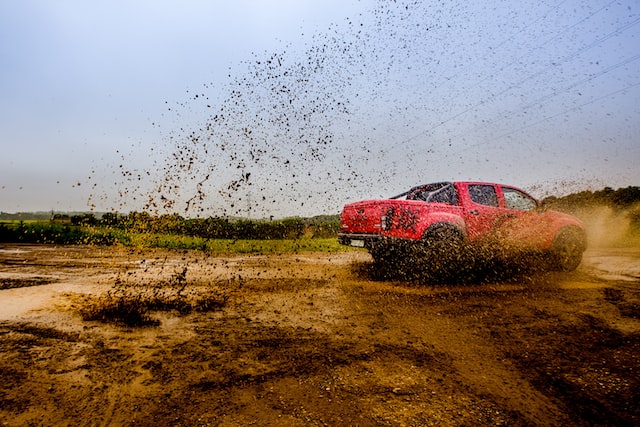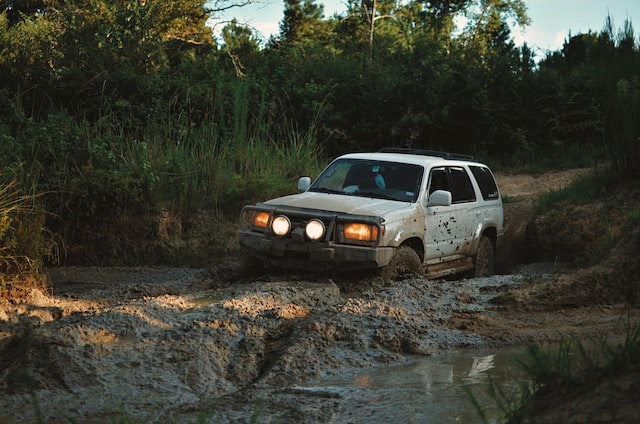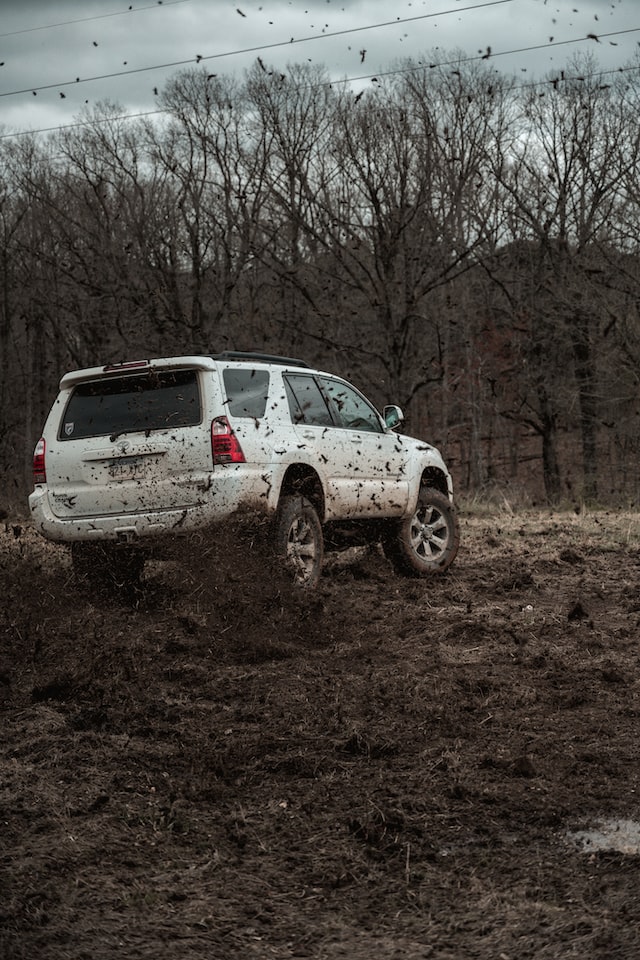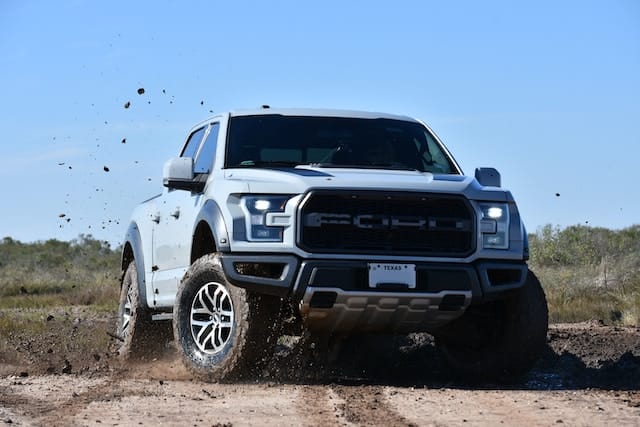
Getting a truck stuck in mud can be frustrating and stressful, especially if you’re in a remote location with no access to help. Whether you’re an off-road enthusiast or a new truck driver, getting a truck unstuck from mud is an essential skill to have. With the right tools and techniques, you can quickly and safely get your truck back on the road.
How to Get a Truck Unstuck from Mud: Step By Step
Getting a truck unstuck from mud can be challenging, but here are some steps you can take:
Assess the situation
First, assess the situation to determine the severity of the mud and the condition of the truck. Check the wheels, tires, and undercarriage for any damage or debris that may be causing the truck to get stuck.
Clear the area
Clear any debris, rocks, or branches around the truck that may be hindering its movement. Remove excess mud from around the wheels and undercarriage.
Use traction aids
Traction aids, such as sandbags, traction mats, or pieces of wood, can provide extra grip for the tires. Place the traction aids in front of the drive wheels to give them something to grip onto.
Rock the truck
If the truck is partially stuck, try rocking it back and forth by shifting between drive and reverse. Use gentle pressure on the accelerator to avoid causing damage to the wheels or transmission.
Pull the truck out
If the truck is deeply stuck, you may need to use a winch or a tow strap to pull it out. Attach the winch or strap to a secure anchor point, such as a tree or another vehicle, and slowly pull the truck out.
Seek professional help
If the truck is severely stuck, or if you are unable to get it unstuck on your own, seek professional help from a tow truck or a local off-road recovery service.
Remember to use caution when attempting to get a truck unstuck from mud. Avoid putting yourself or others in danger, and follow all safety guidelines and procedures.
Differences Between 2WD or 4WD Trucks

Getting a truck out of the mud can be a challenge, but the process varies depending on whether you have a 2WD or 4WD vehicle. Here are the main differences between the two when attempting to free your truck from the mud:
2WD (Two-Wheel Drive) Trucks
Limited Traction
2WD trucks only have power sent to either the front or rear wheels, meaning that if the powered wheels are stuck in mud, there is limited traction available for getting out of the situation.
Rocking Technique
In a 2WD truck, you may need to rely on the rocking technique, which involves shifting between forward and reverse gears while gently accelerating to build momentum and slowly work your way out of the mud.
Traction Aids
With 2WD trucks, it’s often necessary to use traction aids such as sand, gravel, or traction mats under the powered wheels to increase grip and help the truck move out of the muddy area.
4WD (Four-Wheel Drive) Trucks
Improved Traction
4WD trucks have power sent to all four wheels, providing better traction in muddy situations. This increased grip can make it easier to free the vehicle from the mud.
Low Range Mode
Most 4WD trucks have a low range mode, which can be engaged to provide more torque to the wheels and help power the vehicle out of the mud. This mode should be used with caution and at low speeds to avoid causing damage to the drivetrain.
Locking Differentials
Some 4WD trucks have locking differentials that can be engaged to distribute power evenly between the front and rear wheels, further improving traction and the ability to get unstuck from the mud.
Removing a Truck from Mud: Safety Guidelines

Removing a truck from the mud can be a hazardous activity that requires proper planning, preparation, and execution. Here are some safety guidelines to consider when removing a truck from the mud:
Assess the situation
Before attempting to remove the truck from the mud, assess the situation carefully. Check the condition of the truck, the surrounding terrain, and any potential hazards that could cause harm.
Use appropriate equipment
Make sure you have the appropriate equipment for the job, including a tow strap or chain, shovel, jack, and any other necessary tools.
Use a spotter
Have a spotter present to assist in the recovery process. They can help direct the driver as they attempt to get the truck unstuck and can alert them to any hazards.
Turn off the engine
Turn off the engine and engage the emergency brake before attempting to recover the truck. This will prevent the truck from moving and reduce the risk of injury.
Use proper technique
Use proper techniques when recovering the truck. Avoid sudden movements and jerks that could cause the truck to tip or become unstable.
Stay clear of the recovery area
Make sure all bystanders and non-essential personnel stay clear of the recovery area. This will reduce the risk of injury from flying debris or unexpected movements.
Use caution when driving
After removing the truck from the mud, use caution when driving. The tires may be caked with mud, which can reduce traction and increase the risk of accidents.
Inspect the truck
Inspect the truck thoroughly after recovery to ensure that it is safe to operate. Check for any damage that may have occurred during the recovery process.
Remember, safety should always be the top priority when removing a truck from the mud. By following these guidelines and using caution, you can minimize the risk of injury and successfully recover the truck.
Removing a Truck out of Mud: 5 Things to Avoid

When removing a truck from the mud, there are several things to avoid to ensure the safety of those involved and to prevent further damage to the truck or the surrounding area. Here are some things to avoid:
Avoid sudden movements
Avoid sudden movements or jerking actions when attempting to remove the truck from the mud. This can cause the truck to tip over or become unstable.
Avoid using improper equipment
Avoid using improper equipment or tools that may cause damage to the truck or the surrounding area. Only use equipment specifically designed for vehicle recovery.
Avoid overexerting the truck
Avoid overexerting the truck by applying too much force or using too small of an anchor point. This can cause damage to the vehicle’s frame or suspension system.
Avoid ignoring safety precautions
Avoid ignoring safety precautions such as wearing appropriate personal protective equipment and having a spotter present. This can lead to injury or damage to the truck or the surrounding area.
Avoid ignoring the vehicle’s condition
Avoid ignoring the vehicle’s condition after recovery. Inspect the truck thoroughly for any damage or issues that may have occurred during the recovery process.
By avoiding these common mistakes, you can safely remove your truck from the mud and minimize the risk of injury or further damage.
Best Materials to Help Unstuck a Vehicle from Mud, and How Do They Compare?
Sand: The Natural Traction Booster
Sand is commonly used due to its widespread availability and ability to offer good traction. However, its effectiveness can diminish if the mud is wet, as it may mix with the mud and create a slick surface.
Rocks: Sturdy but Risky
Rocks provide excellent traction because of their hard, solid nature. The downside is that they are difficult to position, especially if the vehicle is deeply stuck, and there’s a risk of damaging the tires.
Wood Planks: Spreading the Load
Wood planks can effectively distribute a vehicle’s weight over a larger area, potentially making it easier to get out of a muddy rut. However, they are cumbersome to handle, and there’s a risk they could crack under the weight of the vehicle.
Kitty Litter: Convenient and Absorbent
Kitty litter, particularly the non-clumping type, is popular for its absorbent qualities, which can help dry out the mud and provide better traction. It’s convenient due to its packaged form and lightweight nature. However, it might not be the best choice for heavier vehicles or more severe stuck situations.
Carpet Remnants: The Makeshift Solution
Carpet remnants can offer some traction and are easy to position under tires. However, they may not hold up well under heavy weight or more challenging mud conditions.
FAQ: How to Get a Truck Unstuck from Mud

Q: What are some specific tips for getting a truck unstuck from deep mud?
In deep mud, start by digging out mud from around the tires and under the chassis. If you have a winch, attach it to a sturdy anchor like a tree and slowly pull the truck out. If no winch is available, use a tow strap connected to another vehicle for pulling. Alternatively, a high-lift jack can elevate the truck to place traction aids like wood or rocks under the tires. Always prioritize safety, use hazard lights, and seek professional help if needed.
Q: What are the main differences between getting a 2WD and 4WD truck unstuck from mud?
A: A 4WD truck has improved traction, a low range mode, and sometimes locking differentials, which makes it easier to get out of the mud compared to a 2WD truck. In contrast, a 2WD truck relies on the rocking technique and traction aids like sand, gravel, or traction mats to increase grip.
Q: What is the rocking technique, and how does it work?
A: The rocking technique involves shifting between forward and reverse gears while gently accelerating to build momentum. This back-and-forth motion can help free your truck from the mud by slowly working it out of the stuck position.
Q: Can I use household items to improve traction when my truck is stuck in the mud?
A: Yes, you can use items like sand, gravel, or even a floor mat to improve traction under the wheels of your truck. However, purpose-made traction mats will generally provide better grip and are more durable.
Q: How can I prevent my truck from getting stuck in the mud in the first place?
A: To avoid getting stuck in the mud, drive cautiously in muddy conditions, avoid deep ruts or excessively soft terrain, and use appropriate tires for off-road driving. Additionally, it’s helpful to have recovery gear, such as a winch, tow strap, or traction mats, on hand in case you do get stuck.
Q: Can I use a winch or tow strap to get my truck unstuck from the mud?
A: Yes, a winch or tow strap can be used to help free your truck from the mud. Make sure to use a strong anchor point, such as a tree or another vehicle, and follow safety guidelines when using these tools to avoid injury or damage to your truck.
Q: How important is tire selection for preventing my truck from getting stuck in mud?
A: Tire selection is crucial when driving in muddy conditions. Off-road or mud-terrain tires are designed with deep grooves and large tread blocks to provide better traction and prevent mud from clogging the treads.
Q: Can tire pressure affect my truck’s ability to get unstuck from mud?
A: Yes, reducing tire pressure can increase the tire’s contact patch with the ground, providing more traction in muddy conditions. Make sure not to deflate the tires too much, as this can damage the tires or cause them to come off the rim.
Q: Should I use momentum when driving through muddy terrain?
A: Maintaining a controlled level of momentum can help you navigate through muddy terrain without getting stuck. However, it’s important not to go too fast, as this can lead to a loss of control or getting stuck even deeper in the mud.
Q: What should I do if I don’t have any tools or recovery gear to help me get my truck unstuck from the mud?
A: If you don’t have any tools or recovery gear, try using the rocking technique or improvise traction aids using materials like rocks, branches, or floor mats. If you’re still unable to get your truck unstuck, consider calling for help or contacting a tow service.
Q: Can I use a shovel to help get my truck unstuck from the mud?
A: Yes, a shovel can be helpful for removing mud from around your tires and underneath your truck. This can create a path for your truck to move and increase the chances of getting unstuck.
Q: How can I avoid spinning my tires when trying to get my truck unstuck from mud?
A: To avoid spinning your tires, apply gentle and steady pressure on the accelerator instead of sudden bursts. This will help maintain traction and prevent digging your truck deeper into the mud.
Q: What are the potential risks of attempting to get my truck unstuck from mud by myself?
A: Attempting to get your truck unstuck from mud by yourself can result in further damage to your vehicle or getting stuck in an even worse position. Additionally, using recovery tools like a winch or tow strap without proper knowledge can lead to injury or damage. In such cases, it’s best to call for assistance or a professional tow service.
